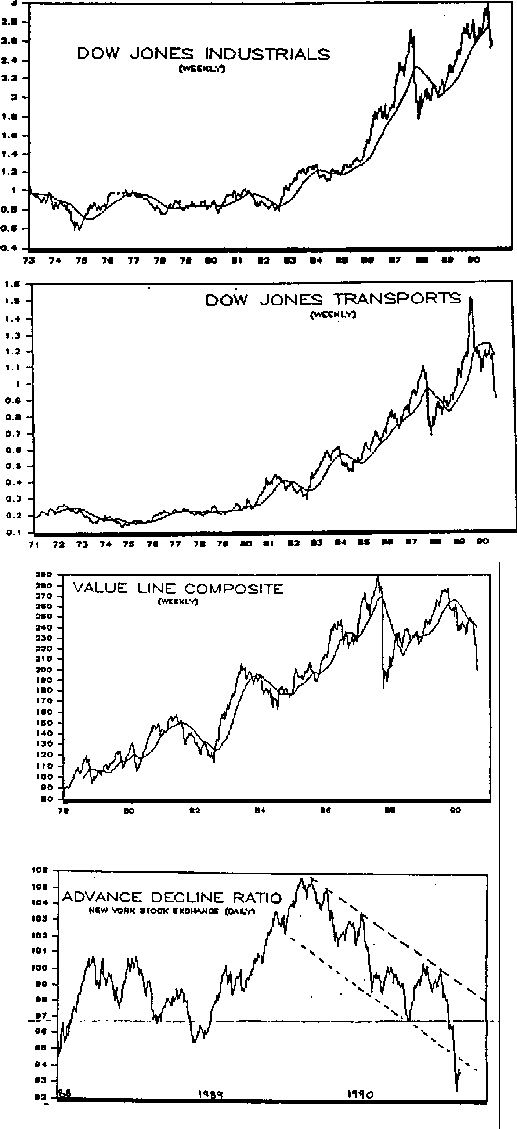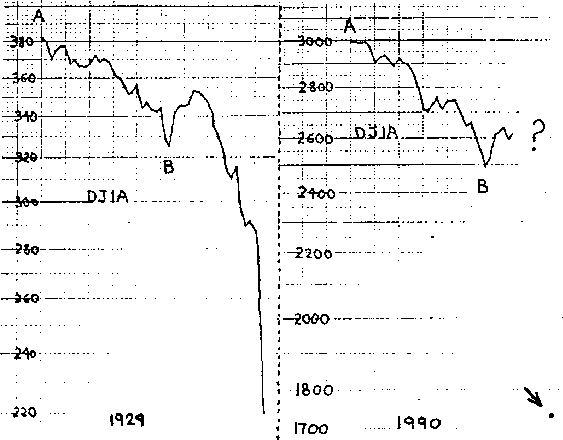
One of the bargain basement equity investments we can make with our cash is, of course, buying back shares of our own stock. By reducing the number of shares outstanding, we multiply the earnings per share from constant earnings, making each remaining share more valuable.

I have nothing against such a strategy, but I don't think now is the time to do it. Every measure I consider reliable tells me that we are in a primary bear market which began several months ago. Strength in the Dow has masked an ongoing massacre in the wider market. The Value Line Composite Index, for example, which comes far closer to reflecting an average stock portfolio, has utterly collapsed and is heading for its 1987 crash low. The advance-decline ratio (breadth), an unweighted measure of all stocks, has fallen to levels not seen since 1985, when the Dow was in the 1300s.
One guideline for analysing very long term stock market action that's been reliable for most of this century has been the dividend yield on the Dow Jones Industrials. At bull market tops, such as in 1987 and the recent record highs, the yield usually drops to 3% or a little less. At bear market bottoms, such as 1974 and 1982, the Dow yield rises to 6% or more. I believe we're currently in a down-cycle which started with the yield well below 3% and will continue until real fear and panic liquidation grips the market. The Dow yield is presently in the 4% range, so I think we have quite a way to go both numerically and psychologically. If no dividend cuts were to occur, a Dow yield of 6% would require the Dow to fall to the 1750 range. In a recession, of course, dividend decreases are the norm, so an even lower target would be expected.
Interestingly, two other unrelated measures suggest a target in the same range. Bear markets have a tendency to erase half the gains of the preceding bull market. If you look at the entire 15 year bull market that carried to Dow from 577 in 1974 to 3000 in 1990, the halfway point is in the 1780s. Finally, the crash low of 1987 was 1738, with a secondary low of 1766 recorded in December of 1987. These lows have not been revisited in the subsequent years. A chartist (and yes, experience has taught me not to disregard this tool for comprehending mass human behaviour as reflected by the markets) would say there is ``strong support'' in the mid 1700s.
Then there is this perspective....

Even if you discount all of this analysis as utter mumbo-jumbo, I'd still urge deferring any stock buy-back on the simple grounds that it's wise to conserve cash at a time when there are so many economic uncertainties. If you believe I may be right about the bear market and expect it to follow the historical pattern of past bear markets, then we should keep the cash in the money bin until the bear brings prices down.
Bear markets, once underway, tend to accelerate and exceed even the
most carefully calculated downside targets. The best indication of
the end of a bear market is when the market refuses to go down further
even in the face of the bleakest of news. Consequently, numerical
(or, some would say, numerological) targets, however calculated, are
no substitute for informed judgement based on consideration of all
relevant factors. That said, if Autodesk stock is today around $45
and the Dow is in the vicinity of 2500, given the beta of our stock
and the historical tendency of smaller stocks to fall further in a
bear market, I'd expect us to be able to repurchase our stock between
$20 and $30 per share at a bear market bottom.![]() This is a
case where being wrong doesn't cost very much. If our stock starts
soaring again, we wouldn't want to repurchase it but then there
wouldn't be any reason to! As long as a downtrend is in effect, I'd
be inclined to continue to ride it down so as to get the most stock
for the funds we devote to the repurchase.
This is a
case where being wrong doesn't cost very much. If our stock starts
soaring again, we wouldn't want to repurchase it but then there
wouldn't be any reason to! As long as a downtrend is in effect, I'd
be inclined to continue to ride it down so as to get the most stock
for the funds we devote to the repurchase.
Editor: John Walker